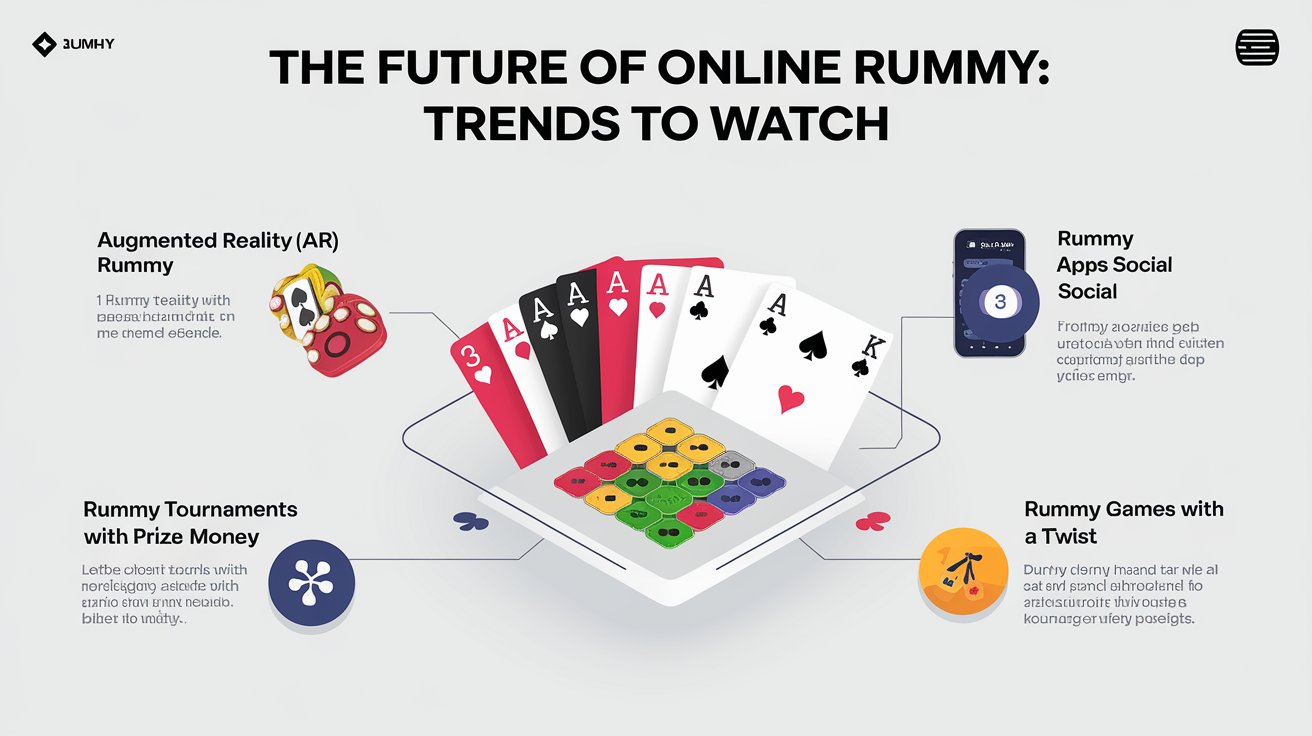In the ever-evolving landscape of online gaming, few card games have demonstrated the staying power and adaptability of rummy. This centuries-old game has successfully transitioned from kitchen tables to digital platforms, creating a thriving online ecosystem that continues to grow and innovate. As technology advances and player expectations evolve, the online rummy industry is poised for significant transformation in the coming years. This article explores the emerging trends and developments that will shape the future of online rummy, offering insights for players, developers, and industry stakeholders.
The Current State of Online Rummy

Before diving into future trends, it’s worth examining where the online rummy industry stands today. Digital versions of rummy have been available for years, but recent technological advancements and changing consumer behaviors have accelerated growth dramatically.
The global online card games market, of which rummy is a significant segment, was valued at approximately $11.5 billion in 2023 and is projected to reach $23 billion by 2030. This growth is driven by increased smartphone penetration, improved internet connectivity, and a growing acceptance of digital gaming platforms.
Online rummy has emerged as particularly popular in countries with strong traditional rummy cultures, including India, Spain, the Philippines, and parts of Latin America. In India alone, the online rummy industry is estimated to be worth over $335 million, with millions of active players across various platforms.
Technological Innovations Reshaping Online Rummy
Artificial Intelligence and Machine Learning
AI and machine learning are revolutionizing how online rummy games are developed, operated, and experienced. Here’s how these technologies are being integrated:
Adaptive Difficulty Levels: AI algorithms analyze player behavior and skill levels to create personalized gaming experiences. For beginners, the system might offer simpler challenges, while experienced players can face more sophisticated opponents.
Pattern Recognition: Machine learning systems can identify and flag unusual playing patterns that might indicate cheating or collusion, creating a fairer gaming environment.
Virtual Assistants: AI-powered assistants are being developed to help new players learn the game, offering real-time advice on strategy and card management without disrupting gameplay.
Predictive Analytics: Game developers are using AI to predict player preferences and behaviors, allowing them to tailor their offerings and marketing strategies accordingly.
Virtual and Augmented Reality
The integration of VR and AR technologies promises to transform the online rummy experience from a two-dimensional interface to an immersive, realistic environment:
Virtual Card Rooms: VR technology allows players to enter virtual card rooms where they can interact with other players in a simulated physical space, complete with customizable avatars and environments.
Haptic Feedback: Advanced haptic technology can simulate the feeling of holding and manipulating physical cards, adding a tactile dimension to the digital experience.
Spatial Awareness: AR overlays can enhance the at-home playing experience by projecting digital elements onto physical spaces, potentially allowing for hybrid physical-digital gameplay.
Immersive Tournaments: Major tournaments could become spectator events in virtual spaces, with audiences watching matches unfold in three-dimensional environments.
Blockchain and Cryptocurrency Integration
Blockchain technology is making inroads into the online rummy ecosystem, offering new possibilities for transparency, security, and economic models:
Provably Fair Algorithms: Blockchain-based systems can provide mathematical proof that shuffling and dealing processes are random and fair, addressing concerns about game integrity.
Cryptocurrency Payments: Many platforms are beginning to accept cryptocurrencies for deposits and withdrawals, offering players greater privacy and potentially faster transaction times.
NFT-Based Cards and Collectibles: Non-fungible tokens (NFTs) could enable unique digital cards or special edition decks that players can own, trade, and use across different platforms.
Decentralized Gaming Platforms: Emerging decentralized gaming ecosystems built on blockchain could eliminate the need for central controlling entities, potentially reducing fees and increasing player control.
Evolving Business Models

Freemium and Subscription Services
The business models supporting online rummy are diversifying beyond traditional pay-to-play structures:
Season Passes: Similar to those in other gaming genres, rummy platforms are experimenting with season passes that offer access to exclusive tournaments and cosmetic items for a set period.
Premium Subscriptions: Subscription tiers that provide additional benefits such as reduced fees, exclusive game variants, or advanced analytics tools are becoming more common.
Ad-Supported Free Play: Some platforms are exploring ad-supported models where casual players can play for free while viewing advertisements, with options to purchase ad-free experiences.
Cross-Platform Integration
The boundaries between different gaming platforms are becoming increasingly blurred:
Unified Accounts: Players can access their accounts across mobile devices, desktops, and potentially even game consoles, with progress and balances synchronized.
Social Media Integration: Deeper connections with social media platforms allow for seamless sharing of achievements, inviting friends, and organizing private games.
Gaming Ecosystem Partnerships: Online rummy is increasingly being integrated into broader gaming ecosystems, with major platforms offering rummy alongside other card games and casino titles.
Enhanced Player Experience
Personalization and Customization
The one-size-fits-all approach is giving way to highly personalized gaming experiences:
Customizable Interfaces: Players can adjust layouts, card designs, and background themes to create a personalized playing environment.
Adaptive Sound Design: Music and sound effects that respond to gameplay intensity and player preferences enhance immersion without becoming repetitive.
Tailored Recommendations: Sophisticated recommendation engines suggest tournaments, game variants, and opponents based on playing history and preferences.
Social Features and Community Building
The social aspect of rummy, traditionally an important part of the physical game, is being enhanced in digital environments:
In-Game Chat and Voice Communication: Advanced communication options allow players to interact more naturally during games, recreating the social atmosphere of in-person play.
Community Events and Challenges: Regular community-wide events, seasonal challenges, and team competitions foster a sense of belonging and ongoing engagement.
User-Generated Content: Some platforms are allowing players to create and share custom game variants, challenges, or even design card backs and table themes.
Skill Development and Learning Tools
As competition increases, players are seeking ways to improve their skills:
Interactive Tutorials: Sophisticated, interactive learning modules help new players master the rules and basic strategies of different rummy variants.
Replay Analysis: Post-game analysis tools allow players to review their decisions and identify areas for improvement.
Skill Matching: Advanced algorithms pair players with others of similar skill levels, ensuring challenging but fair competitions.
Regulatory Landscapes and Responsible Gaming

Evolving Legal Frameworks
The regulatory environment for online rummy continues to develop globally:
Skill vs. Chance Distinctions: Many jurisdictions are refining the legal distinction between games of skill (like rummy) and games of chance, with implications for licensing and taxation.
Standardized Regulations: Industry stakeholders are advocating for more consistent regulatory frameworks across different regions to facilitate growth and ensure player protection.
Age Verification Technologies: Advanced biometric and documentation verification systems are being implemented to prevent underage access to real-money gaming.
Responsible Gaming Initiatives
The industry is increasing its focus on player welfare and responsible gaming:
Self-Exclusion Tools: More sophisticated self-limitation options allow players to set time or spending limits, with mandatory cooling-off periods.
Behavioral Analysis: AI systems monitor playing patterns to identify potentially problematic behaviors and trigger intervention protocols.
Transparent Mechanics: Clearer information about odds, house edges, and mathematical expectations helps players make informed decisions.
Regional Growth and Cultural Adaptation
Emerging Markets
While established markets continue to grow, new regions are emerging as significant players in the online rummy ecosystem:
Southeast Asia: Countries like Thailand, Vietnam, and Indonesia are showing increased interest in online rummy, with localized variants gaining popularity.
Africa: Improved internet infrastructure in countries like Nigeria, Kenya, and South Africa is opening new markets for online card games, including rummy.
Eastern Europe: Countries with strong card game traditions are seeing rapid growth in online rummy participation as digital payment options become more accessible.
Cultural Customization
Successful platforms are adapting to local preferences and cultural contexts:
Variant Prioritization: Platforms highlight different rummy variants based on regional popularity – Gin Rummy in North America, Indian Rummy in South Asia, Canasta in Latin America.
Cultural References and Design: Game environments and promotions incorporate culturally relevant themes, celebrations, and aesthetics to resonate with local players.
Language and Communication Styles: Beyond basic translation, platforms are adapting communication styles, humor, and terminology to fit cultural expectations.
Conclusion: The Road Ahead
The future of online rummy stands at an exciting crossroads of technological innovation, business model evolution, and cultural adaptation. The integration of AI, VR/AR, and blockchain technologies promises to create more immersive, fair, and personalized experiences. Evolving business models will offer players more choices in how they engage with and pay for their gaming experiences. Enhanced social features and community-building tools will help recreate and potentially surpass the social dynamics of traditional in-person play.
As the industry navigates evolving regulatory landscapes and prioritizes responsible gaming initiatives, it has the opportunity to establish online rummy as a sustainable, widely accepted form of digital entertainment. The continued expansion into emerging markets, coupled with thoughtful cultural adaptation, suggests that online rummy’s global footprint will continue to grow.
For players, developers, and industry stakeholders, staying informed about these trends will be crucial for making the most of the opportunities that lie ahead. Whether you’re a casual player looking for entertainment, a serious competitor seeking new challenges, or a business looking to innovate in the space, the future of online rummy offers something to watch with anticipation.
The card game that has brought people together around tables for centuries is now bringing them together across digital spaces, and its next chapter promises to be its most dynamic yet.

Zareb Saleh is a journalist at Gulf Today and a ghostwriter for Gameoholic, specializing in gaming, technology, and digital culture. With a keen eye for industry trends, he delivers insightful stories that engage and inform readers.




